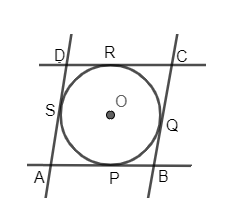
Prove that the parallelogram circumscribing a circle is a rhombus.
Answer
598.2k+ views
Hint: Use the basic geometry concepts of circles lengths of tangents drawn from one external point are equal that is there are two tangents possible from one external point, from which both must be equal
Complete step-by-step answer:

In question the information given is:
A circle with centre O
A parallelogram ABCD touching the circle at points P, Q, R and S.
The point we need to prove is:
ABCD is a rhombus.
A rhombus is a two-dimensional figure with 4 sides, 4 corners. It satisfies the condition of all sides being equal.
By above we can say:
A rhombus is a parallelogram with all sides equal.
It is given in question that ABCD is parallelogram
So, the point we need to prove in order to prove that ABCD is a rhombus is:
All sides are equal
Parallelogram is a two-dimensional figure with 4 sides, 4 corners. It satisfies the condition that opposite sides are parallel and equal.
By applying this condition to the parallelogram ABCD, we get
AB = CD and also AD = BC ………..(i)
From basic geometry of circles there are only two tangents possible from one external point to a circle. It must satisfy condition that the length of tangents must be equal.
By apply above condition to the pair of ABCD parallelogram and circle O, we get:
AP = AS……..(ii)
BP = BQ…….(iii)
CR = CQ………(iv)
DR = DS ……..(v)
By adding equation (ii), equation (iii), equation (iv) and equation (v) we get:
AP + BP + CR + DR = AS + BQ + CQ + DS
By grouping common terms, we get:
(AP + BP) + (CR + DR) = (AS + DS) + (BQ + CQ)
By simplifying, we get:
AB + CD = AD + BC
By substituting equation (i) here, we get:
(i) : CD = AB and also BC = AD
AB + AB = AD + AD
2AB = 2AD
AB = AD……….(vi)
By equation (vi) and equation (i), we get:
AB = BC = CD = AD
all sides are equal.
Therefore, ABCD is a rhombus.
Hence proved.
Note: The idea of grouping and then substituting equation (i) is crucial. Do carefully, or else you might lead to a wrong calculation.
Complete step-by-step answer:

In question the information given is:
A circle with centre O
A parallelogram ABCD touching the circle at points P, Q, R and S.
The point we need to prove is:
ABCD is a rhombus.
A rhombus is a two-dimensional figure with 4 sides, 4 corners. It satisfies the condition of all sides being equal.
By above we can say:
A rhombus is a parallelogram with all sides equal.
It is given in question that ABCD is parallelogram
So, the point we need to prove in order to prove that ABCD is a rhombus is:
All sides are equal
Parallelogram is a two-dimensional figure with 4 sides, 4 corners. It satisfies the condition that opposite sides are parallel and equal.
By applying this condition to the parallelogram ABCD, we get
AB = CD and also AD = BC ………..(i)
From basic geometry of circles there are only two tangents possible from one external point to a circle. It must satisfy condition that the length of tangents must be equal.
By apply above condition to the pair of ABCD parallelogram and circle O, we get:
AP = AS……..(ii)
BP = BQ…….(iii)
CR = CQ………(iv)
DR = DS ……..(v)
By adding equation (ii), equation (iii), equation (iv) and equation (v) we get:
AP + BP + CR + DR = AS + BQ + CQ + DS
By grouping common terms, we get:
(AP + BP) + (CR + DR) = (AS + DS) + (BQ + CQ)
By simplifying, we get:
AB + CD = AD + BC
By substituting equation (i) here, we get:
(i) : CD = AB and also BC = AD
AB + AB = AD + AD
2AB = 2AD
AB = AD……….(vi)
By equation (vi) and equation (i), we get:
AB = BC = CD = AD
all sides are equal.
Therefore, ABCD is a rhombus.
Hence proved.
Note: The idea of grouping and then substituting equation (i) is crucial. Do carefully, or else you might lead to a wrong calculation.
Recently Updated Pages
Two men on either side of the cliff 90m height observe class 10 maths CBSE

What happens to glucose which enters nephron along class 10 biology CBSE

Cutting of the Chinese melon means A The business and class 10 social science CBSE

Write a dialogue with at least ten utterances between class 10 english CBSE

Show an aquatic food chain using the following organisms class 10 biology CBSE

A circle is inscribed in an equilateral triangle and class 10 maths CBSE

Trending doubts
Why is there a time difference of about 5 hours between class 10 social science CBSE

Write a letter to the principal requesting him to grant class 10 english CBSE

What is the median of the first 10 natural numbers class 10 maths CBSE

The Equation xxx + 2 is Satisfied when x is Equal to Class 10 Maths

Which of the following does not have a fundamental class 10 physics CBSE

State and prove converse of BPT Basic Proportionality class 10 maths CBSE




